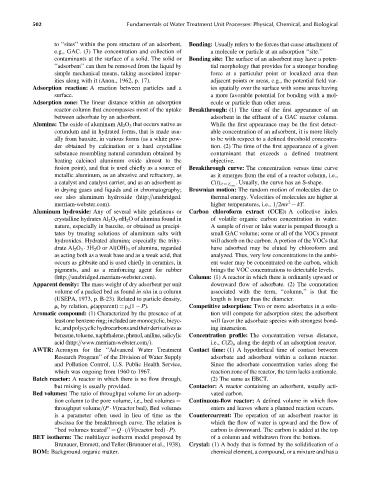Page 547 - Fundamentals of Water Treatment Unit Processes : Physical, Chemical, and Biological
P. 547
502 Fundamentals of Water Treatment Unit Processes: Physical, Chemical, and Biological
to ‘‘sites’’ within the pore structure of an adsorbent, Bonding: Usually refers to the forces that cause attachment of
e.g., GAC. (3) The concentration and collection of a molecule or particle at an adsorption ‘‘site.’’
contaminants at the surface of a solid. The solid or Bonding site: The surface of an adsorbent may have a poten-
‘‘adsorbent’’ can then be removed from the liquid by tial morphology that provides for a stronger bonding
simple mechanical means, taking associated impur- force at a particular point or localized area than
ities along with it (Anon., 1962, p. 17). adjacent points or areas, e.g., the potential field var-
Adsorption reaction: A reaction between particles and a ies spatially over the surface with some areas having
surface. a more favorable potential for bonding with a mol-
Adsorption zone: The linear distance within an adsorption ecule or particle than other areas.
reactor column that encompasses most of the uptake Breakthrough: (1) The time of the first appearance of an
between adsorbate by an adsorbent. adsorbent in the effluent of a GAC reactor column.
Alumina: The oxide of aluminum Al 2 O 3 that occurs native as While the first appearance may be the first detect-
corundum and in hydrated forms, that is made usu- able concentration of an adsorbent, it is more likely
ally from bauxite, in various forms (as a white pow- to be with respect to a defined threshold concentra-
der obtained by calcination or a hard crystalline tion. (2) The time of the first appearance of a given
substance resembling natural corundum obtained by contaminant that exceeds a defined treatment
heating calcined aluminum oxide almost to the objective.
fusion point), and that is used chiefly as a source of Breakthrough curve: The concentration versus time curve
metallic aluminum, as an abrasive and refractory, as as it emerges from the end of a reactor column, i.e.,
a catalyst and catalyst carrier, and as an adsorbent as C(t) Z ¼ Z max . Usually, the curve has an S-shape.
in drying gases and liquids and in chromatography; Brownian motion: The random motion of molecules due to
see also aluminum hydroxide (http:==unabridged. thermal energy. Velocities of molecules are higher at
2
merriam-webster.com). higher temperatures, i.e., 1=2mv ¼ kT.
Aluminum hydroxide: Any of several white gelatinous or Carbon chloroform extract (CCE): A collective index
crystalline hydrates Al 2 O 3 nH 2 O of alumina found in of volatile organic carbon concentration in water.
nature, especially in bauxite, or obtained as precipi- A sample of river or lake water is pumped through a
tates by treating solutions of aluminum salts with small GAC volume; some or all of the VOCs present
hydroxides. Hydrated alumina; especially the trihy- will adsorb on the carbon. A portion of the VOCs that
drate Al 2 O 3 3H 2 O or Al(OH) 3 of alumina, regarded have adsorbed may be eluted by chloroform and
as acting both as a weak base and as a weak acid, that analyzed. Thus, very low concentrations in the ambi-
occurs as gibbsite and is used chiefly in ceramics, in ent water may be concentrated on the carbon, which
pigments, and as a reinforcing agent for rubber brings the VOC concentrations to detectable levels.
(http:==unabridged.merriam-webster.com). Column: (1) A reactor in which there is ordinarily upward or
Apparent density: The mass weight of dry adsorbent per unit downward flow of adsorbate. (2) The connotation
volume of a packed bed as found in situ in a column associated with the term, ‘‘column,’’ is that the
(USEPA, 1973, p. B-23). Related to particle density, length is longer than the diameter.
r s by relation, r(apparent) ¼ r s (1 P). Competitive adsorption: Two or more adsorbates in a solu-
Aromatic compound: (1) Characterized by the presence of at tion will compete for adsorption sites; the adsorbent
least one benzene ring; included are monocyclic, bicyc- will favor the adsorbate species with strongest bond-
lic,andpolycyclichydrocarbonsandtheirderivativesas ing interaction.
benzene, toluene, naphthalene,phenol, aniline, salicylic Concentration profile: The concentration versus distance,
acid (http:==www.merriam-webster.com=). i.e., C(Z) t , along the depth of an adsorption reactor.
AWTR: Acronym for the ‘‘Advanced Water Treatment Contact time: (1) A hypothetical time of contact between
Research Program’’ of the Division of Water Supply adsorbate and adsorbent within a column reactor.
and Pollution Control, U.S. Public Health Service, Since the adsorbate concentration varies along the
which was ongoing from 1960 to 1967. reaction zone of the reactor, the term lacks a rationale.
Batch reactor: A reactor in which there is no flow through, (2) The same as EBCT.
but mixing is usually provided. Contactor: A reactor containing an adsorbent, usually acti-
Bed volumes: The ratio of throughput volume for an adsorp- vated carbon.
Continuous-flow reactor: Adefined volume in which flow
tion column to the pore volume, i.e., bed volumes ¼
throughput volume=(P V(reactor bed), Bed volumes enters and leaves where a planned reaction occurs.
is a parameter often used in lieu of time as the Countercurrent: The operation of an adsorbent reactor in
abscissa for the breakthrough curve. The relation is which the flow of water is upward and the flow of
‘‘bed volumes treated’’ ¼ Q t=(V(reactor bed) P). carbon is downward. The carbon is added at the top
BET isotherm: The multilayer isotherm model proposed by of a column and withdrawn from the bottom.
Brunauer, Emmett, and Teller (Brunauer et al., 1938). Crystal: (1) A body that is formed by the solidification of a
BOM: Background organic matter. chemical element, a compound, or a mixture and has a

